Reconciling Service with C4
Page 58

Page 59

Page 60

Page 61

Page 62

If you've noticed an error in this article please click here to report it so we can fix it.
ly
aley
Inst.'f. DESPITE its name the area of operation covered b.N. Staffordshire Farmers, Ltd., comprises Shropshire, Derbyshire; Leicestershire and Rutland, in addition, of course, to Staffordshire. With headquarters at Wolverhampton, and the transport department located at Cannock. difficulties relative to labour supply and retention can prove more acute for this farmers' trading society than in more truly rural areas. Nevertheless, fleet expansion has continued alongside the overall expansion of the society, which now has total annual sales running at the rate of over three . times those of the immediate post-war period.
In discussing with Mr. F. Wilkinson, general manager and secretary, and Mr. J. Birch, transport officer, how they resolve their distribution problems, Mr. Wilkinson says it is inevitable that members of a society such as theirs should. expect a• high degree of service from their own transport department. This was not always compatible with economic operation, and it was often extremely difficult to strike a fair, balance between cost and service. Superimposed on this„ difficulty was the inherent problem of peak loads inseparable from seasonal. agricultural traffics.
The overall transport policy, under the control of Mr. Wilkinson, is for'. Mr. Birch, as ;transport officer, to be responsible for the Maintenance of vehicles.. These number 206, of which 125 are commercial vehicles operated under C licence. This fleet is dispersed throughout the area, and each of the 19 branch managers are tesponsible for the daily operation of those vehicles allocated to them. There are four branches in Shropshire (Market Drayton, Trench, Shrewsbury and Bridgnorth), five in Staffordshire (Wolverhainpton, Stoke-on-Trent, Stafford, Lichfield and Tamworth), five in Derbyshire (Millers Dale, Chesterfield, Ambergate, Ashhourne and Hatton),four in Leicestershire (AcresfOrd, Earl Shilion, Great Glen and Lutterworth) and one in Rutland (Duddingion). _ • : In addition to the stocking and sale of feeding stuffs. fertilizers, seeds ' and other agricultural requirements, Staffordshire. Farmers, also arovide a bulk fuel service in conjunction with the 'Regent Oil Co., tid., and a tractor
maintenance service in conjunctien with David Brown Tractors (Sales), Ltd.
This wide variety of services supplied to their members is reflected in the range of vehicles operated by Staffordshire Farmers. In addition to 67 goods vehicles there are 14 tankers, 18 mobile shops, four special-type vehicles for the conveyance of tractors and 22 smal vehicles in the 5-cwt. to 12-cwt. range.
The busy times for handling of feeding stuffs and seed grain are mainly during the winter months from September to April, whilst fertilizer deliveries are regulated to some extent by the weather. Feeding stuffs are collected chiefly from Liverpool and Manchester for branches in Staffordshire and Shropshire, from Manchester, Liverpool and Hull for the Derbyshire branches and from London for branches in Leicestershire and Rutland. Transport facilities also have to be available for the engineering department centred at Cannock, whilst machinery has also to be handled at Market Drayton and Ambergate.
How Many Reserves?
Because of the nature of their traffic and the dispersion of branches throughout five counties, it is extremely difficult to determine both the number of reserve vehicles which would be dequate and economic, and also their point of location. Two spare vehicles and one tanker are, in fact, kept at Cannock to meet any emergency that may arise in the overall delivery of feeding stuffs or fuel.
Having allocated the appropriate number of vehicles to each branch, it is up to the local manager to load and route his vehicles to the best possible economic advantage, as his branch will be subsequently debited with their operating costs. Nevertheless, as a branch manager is primarily a salesman there is an understandable tendency to put service before cost when the occasion arises to meet some urgent demand to deliver to a member's farm.
In this respect it is normal procedure for the Society's representative to call on members fortnightly, but to the detriment of economic transport operation a substantial number of telephoned requests for immediate delivery have to be dealt with.
This wide dispersion of vehicles into small groups also makes complications relative to efficient maintenance. The entire fleet is operated on the policy of one vehicle being permanently allocated to one driver who is responsible for washing and greasing. Should minor attention be required B26 to out-based vehicles prior to their scheduled visit transport headquarters at Cannock for the app, docking, this can be undertaken by the local age venient to the branch concerned on authorization Birch.
There is an annual audit of the whole organizz Staffordshire Farmers, including transport, but for purposes Mr. Wilkinson tells me that they also ket branch accounts. To these latter accounts are alloa appropriate amounts for fuel, motor repairs and ar work undertaken by the transport department as the charges rendered by outside garages. All tanker I however, are charged directly to the Cannock acc( is also the expenditure incurred in the operation vehicles.
An exception is made in this method of chargin; case of the two platform-bodied eight-wheelers operate exclusively on collection of feeding stuffs f ports for delivery to the several branches. Exp( incurred in operating these vehicles is debited direc headquarters account and this is recouped by chan branch concerned the recognized haulage rate for This is readily obtainable since, in addition to oi their own ancillary fleet, Staffordshire Farmer occasion to employ the services of both prof hauliers and British Railways.
. The maintenance of stocks of farmers' requiren the various branches is to some extent regulated by tions in the market price and so, to some extent prohibits scheduled deliveries on an economic I accordance with a set schedule.
The Exception As with the method of accounting, the exceptio, routeing of the majority of .vehicles on a day-to-d; is the scheduled operation of the two eight-wheeler: makes five regular return trips per week. Thus collecting from Liverpool delivers to Ashbou Monday, Hatton on Tuesday, Ashbourne again o nesday and Hatton on Thursday, and finally An on Friday.
In 1960 a total of 72,446i tons of feeding stuffs N and delivered by branches for redistribution. Horn grain handled totalled 25,500 tons, half of which wa: on the Society's vehicles. This quantity included wh and barley bought or sold either to flour miller pounders, merchants or farthers. Similarly, about the 45,000 tons of fertilizers handled by the Soci moved on their vehicles.
Lime collection and spreading, however, is contra whilst 2,000 tons of seed potatoes are brought in haulage from Scotland. Wet grain to the extent tons is collected annually from brewers whilst 6,1 of roots, hay and straw is moved roughly in equal tions by hauliers and the Society's own vehicles. . fordshire Farmers do not operate tippers the whol 11,000 tons of pressed pulp collected from sugar tories is move4 either in farmer's own vehicles or tippers. The Society's tankers are at present approximately 24m gallons of fuel a year.
Indicative of the overall expenditure involved operation of their transport department, Mr. Wilkin me that the cost of licensing all vehicles amounts t per annum, whilst repairs and renewals add £64 which £29,000 is incurred at Cannock. Yearly exp on fuel and lubricating oil for the transport depar around £33,000 and the amount debited to depi £33,927. During the past year £52,205 has been to hauliers.
On the development of delivery in bulk to theii members Mr. Wilkinson agrees that it was only
:h member should ask "Row does it reduce my when it is-suggested to him that he should provide ; on his farm for collection and delivery in bulk. , it is hard to justify its adoption by members with Lixed farms who, in any event, do not require subdeliveries at any one time. But it could well be, kinson adds, that the absolute necessity of reducing ion costs still further would compel an even greater specialization by farmers. When that stage is there would be both a much greater need and -ice of the benefits which transport in bulk could
likely developments were in marketing and preThe Society already has plans for the pre ig potatoes and it is anticipated that extra will then be acquired for this traffic in a few months' milady the inauguration of centralized seed-cleaning lso require additional transport, possibly controlled .om headquarters.
• Cost of Transport organization such as theirs with vehicles dispersed 1 groups at several branches, Mr. Wilkinson says ,as easy to underrate the significance of this departa proportion of the entire activities of the Society. -tinent to remember that after salaries and wages, of transport was the greatest single item of expenicurred by the Society. Any economy which could :ved in transport operation, whether internally or urtailment of unreasonable demands on its services, refore have a substantial effect on the fortunes of ety.
In discussing the policy of maintenance and control exercised by Mr. Birch from his Cannock headquarters, he states that each branch allocated with vehicles is required to make a quarterly return to him itemizing the cost of wages, fuel, oil, repairs, tyres, depreciation, tax and insurance. At the same time the branch has to indicate the tonnage moved during that period, the mileage run, fuel consumed and the overall cost per ton delivered. In the office at Cannock a folder is kept for each vehicle on which is recorded a complete history including details of its original acquisition and all subsequent maintenance.
The carrying capacity of the 67 platform vehicles includes two 16-tonners, 13 8-tonners, two 7-tonners, 40 6-tonners, three 5-tonners and seven 4-tonners. The major portion of this fleet consists of vehicles of Guy (29) and ,Foden (27) manufacture, whilst other makes include Austin, Bedford, Commer and Leyland.
The platform bodies of these vehicles are constructed to standard specification by Staffordshire Farmers themselves. Seasoned and dried ash is used which is purchased as a complete tree. Tongued and grooved softwood is incorporated in the flooring. The cabs are standard as supplied by the manufacturer whilst five of the vehicles are fitted with Telehoist sack loaders.
Eight of the Thames 7-cwt. vans operated by fitters attached to the Machinery Department are fitted with Pye tele-communication radio centred on Cannock. In additionradio is fitted to the two cars run by the engineering manager and depot superintendent.
Fourteen Tankers
Of the 14 tankers operated, 12 have a capacity of 1,200 gal. and the remaining two 1,500 gal. These latter two have Bedford 7-ton chassis fitted with Leyland Comet engines. Six of the smaller vehicles have Thames Trader 5-ton chassis, four have Guy Otter chassis with Gardner 4LK engines and the remaining two are Morris 5-tonners. The tanks are constructed by either Darham Industries (London), Ltd., or Thompson Bros. (Bilston), Ltd. In addition to the range of quantities provided by the several compartments of these tankers, a barrel carrier is fitted to the rear of each vehicle to provide accommodation for five barrels of 40-gal. capacity. Fuels delivered include paraffin, fuel, lubricating and vaporizing oils.
The four special-type vehicles includes one articulated outfit consisting of a Guy Otter tractor unit, with Gardner 4LK engine and Eaton 2-speed axle, and a low-loading trailer manufactured by the British Trailer Co., Ltd. This is used for the carriage of farm tractors and is fitted with a 4-ton Thompson winch in the swan neck of the trailer.
A similar-chassis combination, but this time in the form of a rigid vehicle, has the platform built with a tail ramp providing a loading height of 26 in. This vehicle has a Thompson under-floor winch and by the use of a pair of skids tractors can be backed on to the vehicle. This rigid vehicle is employed in confined spaces where it would be difficult, if not impossible, to operate the articulated outfit.
As a development of this method the third special-type vehicle is based on a Bedford TK 5-tonner low-loading chassis with 16-in, wheels onto which has been built a 16-ft. flat platform, and again with an under-floor winch. A breakdown recovery vehicle has been rebuilt in their workshop on an Austin 5-ton chassis reduced to short wheelbase dimensions.
The 18 mobile shops are basically Thames 2-ton vans with oil engines and standard bodies. To these have been added at the Cannock workshops shelving on which hardware and other small equipment is displayed for sale both to the farmer and his wife, and such transactions are completed by the driver-salesman at the farm.
The eight 12-cwt. vans are used by fitters employed on the maintenance of tractors and agricultural implements, whilst a 12-cwt. pick-up truck is used as a depot vehicle by the transport department. All nine are of Bedford manufacture.
Maintenance Centre
The new maintenance headquarters at Cannock were recently constructed at a cost of £.15,000. Four pits are provided, two 18-ft. and two 20-ft. long. An unusual feature of this depot is that the entire floor is heated by electricity whilst the construction has been undertaken by the building department of a sister society, North-Western Farmers, Ltd.
Mr. Birch tells me that this form of heating is proving extremely satisfactory. It is entirely automatic so that no labour costs are involved in maintaining boilers. Because of the evenness of heat throughout the garage, work is carried out where it is most convenient and economic to do so, rather than adjacent to isolated points of heat.
There are also associated advantages which derive from having a heated garage floor. Vehicles which may be brought in wet at night, and particularly during the winter when they may have been driven directly off farmland clogged with wet mud or snow, will be found to be completely dry for the fitters to commence work the following morning. In addition, no pools of water remain on the floor, and when it is necessary for fitters to work at floor level both the surface and any tools or equipment placed on the floor are maintained at an equable temi Precautions, however, must be taken to ensure tha doors only remain open for the minimum time r to get vehicles in and out. This is because the he the garage has been generated over a comparath period and it would take a similar period to res substantial loss of heat caused through doors b open especially during the winter months.
A fully equipped body-building shop is includ( headquarters and all painting and sign-writing is their own staff. Sign-writing, incidentally, is all di hand on Staffordshire Farmers vehicles and the on fers used are for the Regent emblems on the tan for the David Brown markings on vehicles used conveyance of tractors; Bergers paints are used standard vehicle colourings consist of Brunswick the chassis and wings and brilliant green for the re The lettering is done in gold with black shading.
The staff employed at the transport headquarten nock consists of seven mechanics, three apprent four body builders and painters.
Standardization Policy
Due to the acquisitions and expansion undert Staffordshire Farmers since Mr. Birch joined th( 10 years ago (then as transport engineer) a wide makes of vehicles is at present included in the He the Society's intention to evolve some degree of s zation as the older vehicles successively become replacement. In the meantime, however, a star system of maintenance is not readily applicable to ticular fleet, not only because of the diversity o but also because of the urgency of the season carried. Whilst the lighter type of vehicle is sett( be brought into Cannock for attention every 2,f and at double that figure for the heavier vehicles. P considers that despite any such schedule, note, wit priate action if necessary, should still be taken of condition of vehicles. Sound judgment thus sup an adequate maintenance recording system, whic instance Mr. Birch is fully competent to give as a engineer.
Examples of the fuel consumption obtained . standard platform vehicles are as follows. The G are averaging around 21 m.p.g. whilst the Foden average 18 m.p.g. and the 16-tormers 11 m.p.g. Tilt Traders fitted with tanker bodies (and, of cours take-off) average around 15 to 17 m.p.g.




















































































































